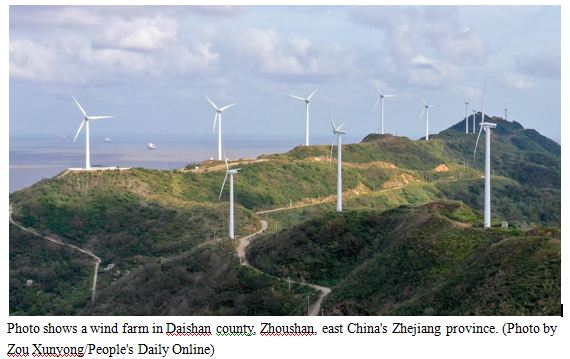By Liao Ruiling
China’s new energy industry is steadily growing. The renewable energy industry, especially the wind and solar power sectors, is becoming an important force in the domestic energy supply.
Wind and solar resources are unlimited given by nature, but equipment components generating the resources have their lifespan.
How should decommissioned wind and solar equipment be recycled? Can equipment recycling be achieved in the green transition of energy? China is finding the answers.
Recently, the National Development and Reform Commission and other departments jointly issued a guideline on promoting the recycling and reutilization of decommissioned wind-power and photovoltaic equipment.
“We have so far recycled about 5,000 tons of photovoltaic modules, and the whole-year figure is expected to reach 7,000 tons,” said Zhuang Huliang, vice general manager of PVRC, China’s first private company specializing in dismantling and recycling waste photovoltaic modules based in Changzhou, east China’s Jiangsu province.
“As the conversion efficiency of photovoltaic modules gradually improves in China, some old equipment in solar plants retired ahead of schedule, bringing more recycling opportunities for the industry,” Zhuang told People’s Daily.
China has become the world’s largest producer and user of wind and solar power, with cumulative and newly installed capacity ranking first globally for many consecutive years.
Zhuang said that generally, a single photovoltaic panel lasts 25 to 30 years, and China is expected to see massive module retirements from 2025 onwards, and the amount of module retirements will increase year by year.
The lifespan of a wind turbine is usually about 20 years. “By 2025, over 1,800 onshore wind turbines in China will be decommissioned. The number will exceed 34,000 by 2030, with an installed capacity of approximately 45 million kilowatts,” said Xu Junxiang, head of the China National Resources Recycling Association.
Decommission doesn’t necessarily mean that the equipment should be abandoned. In fact, these wind and solar equipment still have high recycling value.
“It’s estimated that 35 million tons of waste will be generated in China from decommissioned wind and solar equipment by 2030. These retired equipment contain abundant resources,” said Yao Xin, vice dean of the Research Institute for Environmental Innovation (Suzhou) Tsinghua.
According to Yao, preliminary estimates show that decommissioned wind turbines with an average capacity of one megawatt can reclaim 100 to 240 tons of steel, copper, aluminum and fiberglass, while retired photovoltaic equipment of the same capacity can reclaim 60 to 80 tons of copper, aluminum, plastic and other materials.
Establishing a recycling system for decommissioned wind and solar equipment can effectively improve the efficiency of raw material utilization and reduce the extraction of virgin resources, Yao noted.
To properly recycle decommissioned wind and solar equipment, it is important to set up the rule that one is responsible for the waste it generates.
The guideline urges and guides centralized wind and solar power generation enterprises to dispose of retired equipment according to law. It bans illegal disposal including arbitrary landfilling and discarding, and prohibits abandoning industrial solid waste into domestic waste collection facilities.
It also requests power generation companies to take waste recycling and proper disposal as an important part of wind farm renovation and upgrading projects.
The guideline offers advice on how to recycle. Zhuang said it demands power generation enterprises and other primary waste producers, in partnership with professional recycling institutions, to form specialized recycling systems. It could avoid irregular disposal of retired wind and solar equipment that would lead to resource waste and environmental pollution.
Insiders believe that R&D of related technologies is indispensable for establishing a sound mechanism for recycling decommissioned wind and solar power equipment. The efficiency of component recycling would increase as technology developed, which not only makes recycling more economical, but also drive healthy development of the industry through continuous technological upgrades.
“The guideline will build a solid foundation for efficient recycling of China’s decommissioned wind and solar equipment. With the implementation of relevant policies, China is expected to forge a wind and solar equipment recycling industry with a scale of over 10 billion yuan ($1.08 billion), and provide valuable references for the recycling standardization of other large equipment,” said Yao.












